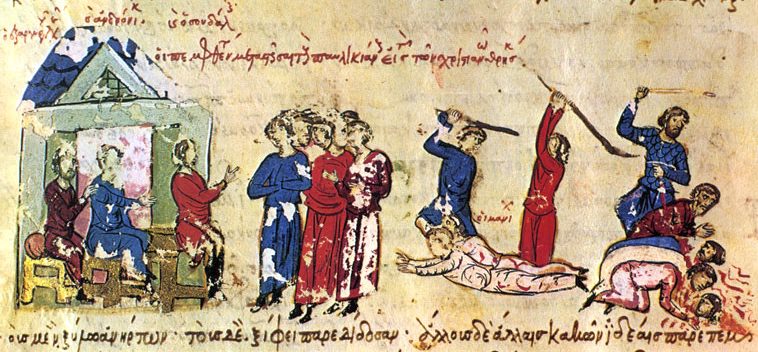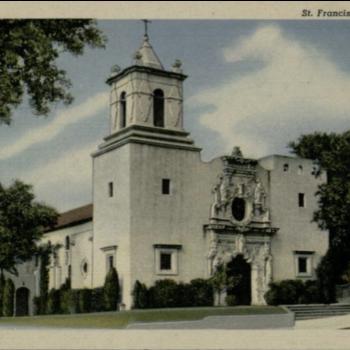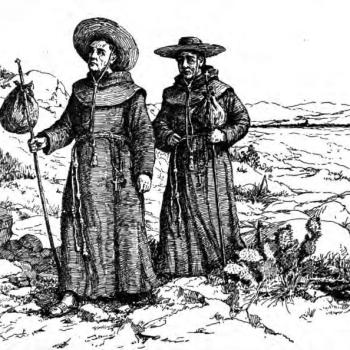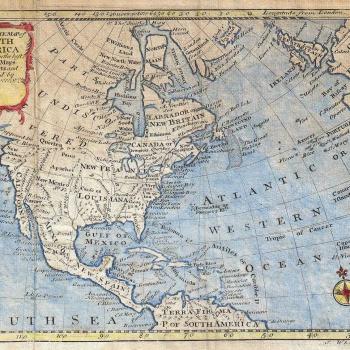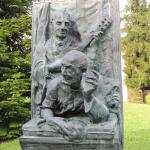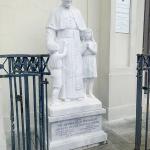Empires move or deport populations, often against the will of those subject peoples. Such movements can have the quite unintentional result of fostering and spreading new religious developments, often of a kind that imperial authorities strongly disfavored. The consequences can last for centuries.
The Heretics on the Borderlands …
Empires are deeply concerned abut maintaining public order and stability, and such concerns are all the greater in border regions, where a revolt might open the door to foreign invasion. When an empire has reasons to suspect a subject people, it is likely to relocate it, perhaps thousands of miles away. In the First World War, the Ottoman Empire initially decided to deport the Armenian minority that it suspected of pro-Allied sympathies, although that movement rapidly escalated into genocide. In that case, the effect was to wreak terrible devastation on a population following an ancient religion, in this case, Christianity. But the religious consequences of such a move can be very different, and far more positive or productive. One of the best examples of that also occurred in that very same territory, of Armenia and eastern Asia Minor.
I have stressed how, historically, dissident and controversial religious ideas flourished at the edges of empire, where enforcement mechanisms were weak. In the context of the Later Roman and Byzantine Empires, that was especially true of the eastern borders with Armenia, which preserved many older beliefs and doctrines that had been suppressed in the empire itself, together with the documents and alternative scriptures that supported them. It was not surprising, then, that around 650, a new sect arose in this part of the world that closely resembled older Christian heresies, including Adoptionism, Marcionism, Manicheanism, and strands of the larger Gnostic world-view. Thew new movement became known as Paulicianism. It had Dualist elements, (probably) teaching that Christ represented the God of the New Testament, while rejecting the Old Testament. They also rejected the veneration of Mary, associated as it was with ideas of material incarnation, as well as many aspects of Orthodox devotion.
The Paulicians became extremely powerful in Armenia, ruling their own territories. As their ideas expanded into the Byzantine-ruled areas of Asia Minor, so the emperors naturally persecuted what they called the “Manicheans,” killing thousands.
From the mid-eighth century, the Byzantine emperors tried a new policy, using the Paulicians as military surrogates in their western territories, particularly in the Balkans. This was no instant transfer, but was spread over a lengthy period, culminating with the transfer of a reputed 200,000 of the sect in 970. These settled Philippopolis in Thrace (modern Plovdiv, Bulgaria). Here, those tough mountain people would help defend the borders against the Bulgarians, who were placing ever-greater pressure on the frontier.
It was a win-win situation. The Paulicians would be weakened massively in the east, while they would be kept busy as faithful guardians of the border in the west. Their survival depended on maintaining that border.
What could go wrong?
I’m sorry, but did I hear somebody say “Isn’t that a really bad idea, because those religious dissidents would take their beliefs with them, and plant them in a whole new territory? Wouldn’t it be a kind of heretical church planting, on a transcontinental scale?” And you would be correct. Already under the year 755-56, the ninth century chronicler Theophanes reports that “The Emperor Constantine [V] resettled in Thrace the Syrians and Armenians he had brought from Theodosiopolis and Melitene; they have spread the Paulician heresy.”
In the mid-tenth century, there arose in Bulgaria the very important sect of the Bogomils. As with the Paulicians before them, there is some doubt about just how fully Dualist they were, but what we can say confidently is that – what was that phrase again? – the Bogomils closely resembled older Christian heresies, including Adoptionism, Marcionism, Manicheanism, and strands of the larger Gnostic world-view. For centuries, Western church figures would use “Bulgarian” as synonymous with Dualist heresy.
… And Their Strange Books
I also wonder what else the Paulicians and their clergy might have brought west with them?
In the study of lost and apocryphal scriptures, some of the most exciting finds in modern times have occurred in the so-called Slavonic Pseudepigrapha, a whole library of ancient Jewish texts preserved in the Slavonic-speaking churches of eastern Europe. These included long-forgotten works as 2 Enoch and the Apocalypse of Abraham, some of which dated from the Second Temple Era, and which often presented strongly Dualist views. (“Pseudepigrapha” means a work falsely attributed to some venerated figure, such as Moses or Ezra). In many cases, these texts were utterly forgotten elsewhere, and existed in no other languages, so their modern rediscovery has transformed the academic study of early Judaism, Christian origins, and the roots of Jewish mysticism. Were it not for those Slavonic translations, we would never have suspected that most of those works ever existed.
Just where these priceless texts were translated into the Slavonic languages is uncertain, but an excellent candidate for the venue would be the Bulgarian royal and ecclesiastical center of Ohrid, probably in the eleventh century (Ohrid is now part of North Macedonia). I discuss these origins in detail in my 2015 book The Many Faces of Christ.
Conceivably, the imperial decision to move those Paulicians not only brought the heretics and dissidents, but also their learned figures, and even a whole library of otherwise lost texts that had been preserved in Armenia, conveniently beyond the grasp of Byzantine censors. I stress the “conceivably”: I can’t actually prove how these writings migrated, but that seems to me a plausible reconstruction. If there is not a linkage from the Paulician settlement through the Bogomils to the new Western heresies, then we are dealing with some very strange and far-fetched coincidences.
Here is another example, which concerns the so-called Revelation (or Apocalypse) of Peter. A number of works circulated under this title, but the most notorious was the Gnostic Apocalypse of Peter, which was discovered at Nag Hammadi in Egypt. It was Gnostic in the sense that the author believed that the material world was ruled by a defective lower God, while Christ was an emissary from the forces of Light. Peter thus taught monstrous heresy, and the book had to be utterly suppressed – hence the burial at Nag Hammadi sometime about 380. And so, scholars believed, it was completely lost until it was rediscovered in 1945.
But that chronology is just wrong. In 1045, in Constantinople, the Orthodox monk Euthymius, denouncing the Bogomils, described a potent initiation rite in which the heretics read the words of a “Revelation (or Apocalypse) of Peter.” Euthymius claimed that this “Satanic spell” exercised a stunning influence: “If the heretics get in first, reading this to a man, the devil makes his house in him and brings him to complete destruction. From then onwards, no arguments about knowledge of God enter his soul.” Given the close harmony between Bogomil views and the Gnostic Apocalypse of Peter, it is very likely that this is the work Euthymius was referring to – some seven hundred years after the last known copy of the work supposedly vanished into the Egyptian desert.
Incidentally, the other place that produced a comparable range of otherwise unknown ancient scriptures, both Jewish and Early Christian, was in Ethiopia, which also stood beyond the immediate span of Roman imperial power.
From the point of view of the Orthodox/Catholic institutional churches, this heretical expansion was disastrous, but worse was to come. During the eleventh century, views very much like the Paulicians and Bogomils increasingly appeared in Western Europe, especially in southern France and Italy, where they became known as the Albigensians, or Bulgarians: the now-popular term “Cathar” was little used at the time. In the thirteenth century, the crusade against the Albigensians devastated large sections of southern France. The struggle to suppress the heresy led to the creation of a fearsome new tactic in the form of the Inquisition. Albigensians persisted at least into the 1320s.
A great deal of ink has been shed about the actual religious views of these groups, and many scholars see them as an activist church reform movement, rather than outright Dualist. However, as I have argued, many of their views do bear a close resemblance to those older Bulgarian and Eastern beliefs. The Albigensians also had access to otherwise lost alternative gospels and scriptures, one of which has been preserved as The Secret Supper. Very much like the famous Gnostic Gospels of antiquity, the Supper purports to be a record by the Apostle John of secret dialogues with Jesus, and it really is Dualist. We also know how the Inquisition labeled this text: “This is the secret book of the heretics of Concoreze [sic], brought from Bulgaria by their bishop Nazarius; full of errors.” I wonder if it had once stood on a library shelf next to other writings that we today know as the Slavonic Pseudepigrapha? Or the Gnostic Apocalypse of Peter? And what other Bulgarian-derived texts might have circulated in Western Europe without finding their way into the hands of the Inquisition?
It’s a near miracle that we still have the Secret Supper, and without its survival, we would never have dared speculate that such a thing existed and circulated in the High Middle Ages, some eight centuries out of its time.
The Byzantine Empire thought it was shoring up its Western borders by importing some Armenian warriors. It did not expect to be launching a European religious revolution.


